The country examples that follow are grouped by mode of transport: walking & cycling; school bus; public & shared transport, and two- & three-wheelers. Although vulnerable and marginalized populations should be included in all journeys, one section focuses entirely on this group. Another focuses on improving air quality, and the last provides examples of school drop-off and pick-up during the pandemic.
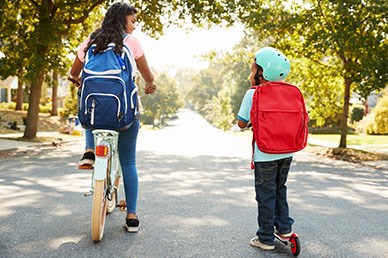
During the COVID-19 pandemic, physical activity for children has been restricted, such as recess/break time and sports. Walking, cycling, or scooting to and from school can help keep children and their caregivers physically active. Active travel supports physical and mental health particularly if routes include access to parks and green spaces, and can help boost concentration. COVID-19 is also less likely to spread outside, where it’s easier to physically distance, and there is better air circulation. Walking creates opportunities for physically distanced social interactions that can help rebuild community connections, and being regularly physically active even a few days a week can help develop new habits that can last a lifetime. These changes are an important part of healthy urban lifestyles.
Walking, cycling, or scooting to school instead of driving can help to decrease road danger and congestion, and lower air pollution, by reducing the number of vehicles. Active travel can also free up space on school buses and public transport for those who need it, such as those who must travel longer distances to school. It is vital that routes to and from school are safe and have dedicated space for walking and cycling to encourage people to shift away from private vehicles. Detailed guidance.
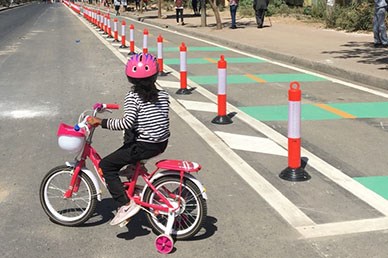
PROMOTE WALKING AND CYCLING: Use both a short- and long-term strategy, as the Ethiopian government has done, working with CHI partners WRI and the UNEP Share the Road programme in Addis Ababa. In the short term, this involves:
Retrofitting streets and public spaces with safe, accessible and inclusive walking and cycling facilities, such as bike lanes segregated from traffic, implemented with design support from NACTO-GDCI;
Providing input to the school reopening plan being prepared by the Ministry of Education;
Presenting and discussing best practices at the Weekly Emergency Response Team Call chaired by the Ministry of Transport
Prioritizing the Safe Routes to School Program and scaling interventions
Engaging in mass media campaigns in partnership with the Ministries of Transport, Health, and Environment
Scaling and launching the Safe Routes to School Program at the national level
Scaling Ethiopia’s car free day / open streets day
Investing in pedestrian and cycling facilities especially along school routes.
Putting in place policies and budgets for constructing and maintaining walking and cycling routes.
IMPLEMENT QUICK CYCLE-FRIENDLY INTERVENTIONS: The Indian Government is encouraging pop-up cycle lanes, traffic-calming schemes or non-motorised zones through the India Cycles4Change Challenge.
INCREASE ENFORCEMENT OF SPEED LIMITS: Vietnam launched a school speed enforcement initiative, wherein the police issue reminders in school zones about speed limits the first week, and then follow up with fines and penalties thereafter.
RE-ACTIVATE PHYSICAL ACTIVITY: Ninas y Ninos primero (Kids First) is a mobility program in Bogota, Colombia, that supports children walking and cycling to school by using ‘walking and cycling caravans’. While schools were closed, the program held adapted activities to encourage children to by physically active. Small groups (6 students and 2 adults) travelled to public spaces to undertake recreational, physical and learning activities, in a Covid-19 secure way.
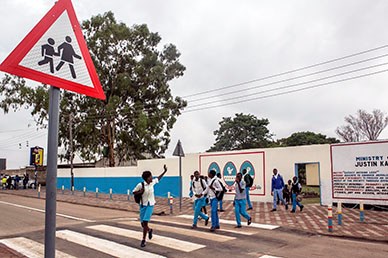
MEASURE RISK ON ROADS: Help users measure risk on roads around schools and identify cost-effective infrastructure changes to increase safety through iRAP’s Star Rating for Schools app. In Vietnam, for example, AIP Foundation used the app as part of the Walk This Way programme and installed speed bumps, road markings, speed reduction signs, and sidewalks. AIP Foundation’s Slow Zones, Safe Zones program in Vietnam reduced maximum speeds at target schools by as much as 18-21 km/h. The success of the scheme means it is being expanded across the country. Star Ratings for Schools has also been used in countries such as Iran and Colombia.
REDUCE SPEEDS WITH LOW-COST INFRASTRUCTURE AND LOWER SPEED LIMITS: Use speed humps, bollards, and crosswalks to make it safe for children to walk to school. AMEND’s SARSAI reduces injury rates by as much as 26%.
EMPOWER STUDENTS TO IDENTIFY ISSUES AND SOLUTIONS: Ask students to share their thoughts on their journeys to school. Use props such as green cardboard cutouts of magnifying glasses to show what students like, and red ones to show what makes them feel unsafe. Work with students to re-design the streets around their school to lower speeds and allow them more space to walk, like ITDP’s Vision Zero for Youth in Mexico City. Engage students with disabilities in all discussions.
CONNECT STUDENTS AND DECISION MAKERS: Initiate a dialogue between youth and decision makers. WRI India did this as part of Vision Zero for Youth. Use video conferencing to connect remote populations with leaders. AIP Foundation brought together students with government representatives in Cambodia, providing youth with the opportunity to share their ideas on improving the safety of dangerous roads near their schools.
MAKE STREETS KID-FRIENDLY: Bogotá, Colombia reclaimed street space with low-cost measures like paint and planters to create a pop-up plaza that became a fun, safe place for families to enjoy and for kids to learn to ride bikes. Similarly, São Paulo transformed an intersection, and reduced pedestrians unsafely walking outside of pedestrian facilities by 42%. Designate days for car-free streets so residents can reclaim and enjoy public space, like Gurgaon, India’s Raahgiri Day.
MAKE STREET SPACES BRIGHT AND ENJOYABLE FOR KIDS. Work with city authorities to use paint to transform spaces, as an interim intervention prior to significant capital construction. In Fortaleza, Brazil, NACTO-GDCI did this through an incremental approach by testing scenarios, collecting metrics, and gathering community feedback. This is particularly important in informal neighbourhoods, where uneven street profiles or oddly-shaped open spaces often require more flexibility in approach. Use bright paint to transform a space, and benches, plants, and other features that children can climb and play on to help them enjoy the public realm.
USE A WALKING SCHOOL BUS: Identify a designated adult to pick up, lead, and supervise children along a safe predetermined route their route to school, as piloted in China by AIP Foundation. This helps maintain the same circle of exposure, or bubble.
USE A CYCLING SCHOOL BUS: This is similar to a walking school bus, but with bicycles. Bogotá, Colombia uses these and also hosts a weekly Ciclovía, in which it makes over a hundred kilometres of roads car-free. A free bike school helps children learn how to ride.
USE INCENTIVES: Use a photo contest to raise awareness about speed reduction in school zones. Use friendly walking games like a ‘golden shoe’ award for the class with the most walkers. Give children a badge to incentivize them to keep walking to school, like the UK’s Living Streets program. Overall, this has led to a 30% reduction in car journeys and a 23% increase in walking rates. For every £1 spent, there were £7.64 in benefits to the wider community.
MAKE IT SAFE FOR WOMEN: Use free apps like Safetipin to make it safe for women to use public spaces. The app has been used to improve lighting at more than 5,000 locations in Delhi, and helped more women in Bogotá use bike paths after dark. AIP Foundation, working together with the Asian Development Bank (ADB) and road safety ambassadors from Thuy Loi University in Hanoi used the Safetipin App to gather personal safety data around Hanoi’s Metro Line 3. They assessed parameters such as light, security, footpaths, proximity to windows, crowdedness and gender disparities to create a safety score for a specific point on the map.
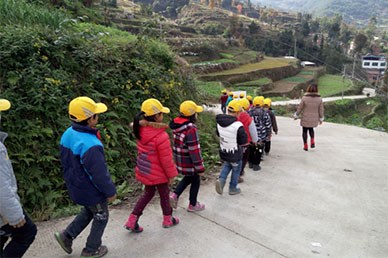
MAKE STREETS SAFER FOR CHILDREN: WHO's How Save Lives Applies to Children, Ten Strategies for Keeping Children Safe on the Roads; Child Health Initiative’s Speed Vaccine; National Center for Safe Routes to School's Benefits of Slowing Down Traffic – Starting Where Children Walk and Bike
FORM A WALKING SCHOOL BUS: EDWeek and Safe Routes Partnership
FORM A CYCLING SCHOOL BUS: Safe Routes Partnership
TRANSFORM STREETS AROUND SCHOOLS INTO STREETS FOR KIDS: NACTO Streets for Kids Guide; Bernard van Leer Foundation’s Urban 95 Starter Kit; UK Supplementary Guidance on School Streets; The City at Eye Level for Kids; UNICEF’s Shaping Urbanization for Children
MAKE STREETS SAFER THROUGH INFRASTRUCTURE: WRI’s 6 Road Design Changes That Can Save Lives; Infrastructure Design & Improvement and video
TEACH CHILDREN TO BE SAFE ROAD USERS: EASST’s Road Safety Education Pack; Everyone is a Pedestrian campaign; Teaching Children to Walk Safely As They Grow and Develop
ESTABLISH POLICY FRAMEWORKS AT THE CITY OR NATIONAL LEVEL: Share the Road's NMT toolkit
RESOURCES SPECIFIC TO AFRICA: Toolkit for Child Health & Mobility in Africa; Share the Road’s Design Guidelines for Non-Motorised Transport in Africa; ITDP’s Streets for Walking and Cycling
RESOURCES SPECIFIC TO INDIA: Urban Design in times of COVID-19: Imagining a post-pandemic city
Wherever possible, treat school buses as extensions of the classroom. They should have the same level of hygiene, physical distancing, and equity. Detailed guidance.
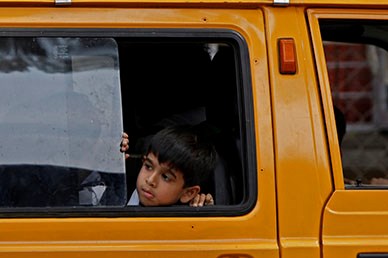
SUPPLY DRIVERS WITH NECESSITIES: Provide drivers with personal protective equipment, hand sanitizer, and masks as ChildSafe South Africa have done through their Safe Travel to School Initiative. Drivers are given: a thermometer; five masks for the driver, one for each day of the week; masks for the students; 2 litres of hand sanitizer; three litres of disinfectant with a spray bottle; an attendance register; local government guidance for transporting children during COVID-19, and a checklist for symptoms.
COLLABORATE WITH TRANSPORT AUTHORITIES: Work with the local, regional or national transport authorities on school bus and public transport sanitation and cleaning, like WRI in Addis Ababa, Ethiopia. WRI participates in the weekly Emergency Response Team Call chaired by the Ministry of Transport and engages in mass media campaigns in partnership with the Ministries of Transport, Health, and Environment.
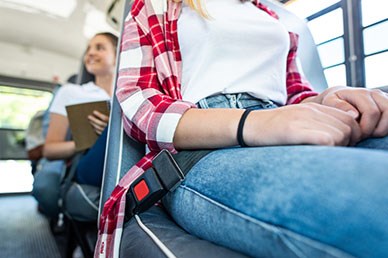
USE SCHOOL BUSES AS “MOBILE BILLBOARDS” FOR AWARENESS MESSAGES: Print banners and place them along the sides of school buses to bring health tips directly to students, bus drivers, and school staff. This also helps spread messages to the broader community as the bus passes through. Banners could include tips for how to stay healthy and distanced before, during, and after a ride, like AIP Foundation did in Cambodia to share COVID-19 transport tips with garment factory workers.
IMPLEMENT PROPER RESTRAINTS IN SCHOOL BUSES: Make seat-belts mandatory for all, as well as child restraint systems for children under three, like Fondation Gonzalo Rodriguez did in Uruguay. They worked alongside a car manufacturer and child seat manufacturer to replace the entire school transport fleet in Montevideo.
HAVE A PLAN FOR WHEN STUDENTS FAIL A HEALTH SCREENING: Steps for Bus Drivers When Students Fail a Screening
CONSIDER THE IMPACT OF SCHOOL SCHEDULES ON TRANSPORTATION: Solving the Student-Transportation Conundrum
SEE SAFE KIDS WORLDWIDE BEST PRACTICES FOR SCHOOL BUS SAFETY
In many countries, public or informal shared transport modes are important to give older children independent access to schools that may be too far away to easily walk or cycle to, or for younger children to be safely accompanied by caregivers. Many recommendations on school buses may be relevant for other shared modes of transit. As schools have limited influence on public transport, ministries should share information and apply new protocols to these modes. It is vital that wider transport systems are designed with family mobility in mind, recognising the complex journeys that caregivers may need to make.
Motorcyclists should wash their hands after riding. Children should ride behind the driver—rather than at the front of the motorcycle—to avoid exposure to germs from other riders. In the event of a crash, this is also a safer place than at the front of the motorcycle. Drivers and passengers should know that road crashes are their biggest safety threat, not exposure to COVID-19. For this reason, it is more important to wear a helmet than extra protective gear like plastic face shields, which would preclude a helmet.
There may also be personal security issues for young people travelling alone on public or shared transport, including motorcycle taxis. Three-wheelers used by students with disabilities should ideally be fitted with safety belts. Detailed guidance.
RETROFIT RICKSHAWS: In India, a driver installed a plastic or metal sheet between the driver and passengers. Others installed sheets between the passengers to separate them from each other.
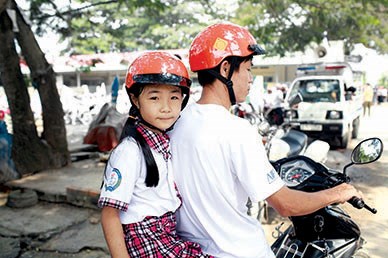
MANDATE MOTORCYCLE HELMETS: Thanks to campaigning by the AIP Foundation, a new law in Vietnam mandating helmet use prevented 500,000 head injuries and 15,000 fatalities, saved $3.5 billion USD in medical costs, lost output, pain, and suffering, and resulted in 24% less injuries and 12% less fatalities. Reducing transport injuries provides medical services more time to address pandemic-related needs. Motorcycles are already 80% of the vehicle market the Asia Pacific region and sales may increase in response to the pandemic as people seek to avoid public transport.
CREATE A CULTURE OF SAFETY: Increase helmet use to decrease motorcycle death and injury among children, like The 7% Project. A national campaign worked with schools to advocate for helmets to be part of the school uniform, and mobilized communities, children, parents, teachers and the general public to jointly create a culture of safety. When the project began, 1.3 million school-age children in Thailand were traveling to school on the back of a motorcycle, but only 7% of them wore a helmet. The project was led by The Network of Child Protection and Road Accident Prevention Specialists, Save the Children and AIP Foundation.
ELECTRIFY VEHICLES: Put policies in place like countries from China to Sri Lanka to support the use of electric vehicles. UNEP is a resource for policy development, best practices, technology pilots, vehicle uptake tracking, emissions calculations, and economic benefits.
ENGAGE THE COMMUNITY TO MAKE LOCAL PUBLIC AND INFORMAL TRANSPORT SAFE: Educate commercial motorcycle taxi drivers about child rights and child safeguarding, and actively invite them to consider their role as protectors of girls’ rights. Save the Children has done this with male Boda Boda (commercial motorcycle taxis in Uganda and elsewhere) drivers to address their reputation of predatory sexual behaviors, targeting school girls with offers of free rides, small gifts and money in exchange for sex. Since initiating dialogue, police receive fewer reports of sexual abuse, Boda Bodas have promoted safety for girls and boys on the radio and TV, and they have asked for additional training in first aid, child rights, child abuse, and gender sensitivity to make them even better advocates for children in their communities.
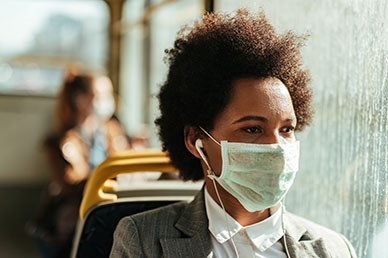
ENCOURAGE SILENCE AND PHYSICAL DISTANCING, WHICH CAN HINDER THE SPREAD OF COVID-19 AND HELP COMBAT GENDER-BASED VIOLENCE, BULLYING, AND SEXUAL HARASSMENT: Transaid Gender Based Violence Posters
ENSURE SAFETY STANDARDS: WHO’s Powered two- and three-wheelers
FOLLOW PROPER COVID-19 PROTOCOLS: Transaid’s Truck Driver Cab Cleaning Guide and Truck Driver Sensitisation
KEEP WOMEN SAFE ON PUBLIC TRANSPORT: COVID-19 and Ensuring Safe Cities and Safe Public Spaces for Women and Girls
RESOURCE SPECIFIC TO RURAL AREAS: Enhancing the understanding on safe motorcycle and three-wheeler use for rural transport
Ensure equal access for vulnerable populations, including those with restricted mobility or additional needs. The journey to school can be an obstacle to education for populations already facing inequity. Detailed guidance.
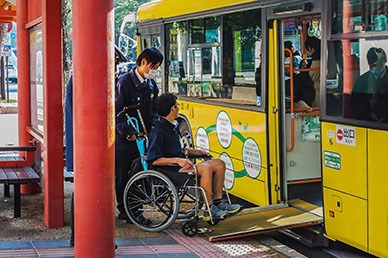
INSTALL AUTOMATIC WHEELCHAIR RAMPS: This allows a student to board a vehicle without needing to come in contact with the driver. South Africa installed these ramps in a mini-bus, as well as flip-up seats to eliminate lost seats when not used by passengers in wheelchairs. Seek to minimize gaps between an occupied wheelchair and the seat of a minibus or van in order to safely and quickly transfer a student between the wheelchair and the seat of the vehicle.
MODIFY WALKWAYS AND PUBLIC TRANSPORT: When planning public transport routes for students with disabilities, work with transport operators to provide accessible buses, such as those with audible and visual information, and level boarding without a gap between vehicles and the station or stop, as South Africa has done as part of their Public Transport Strategy.
MAKE THREE-WHEELERS ACCESSIBLE: Install well-placed hand grasps, padding to protect passengers from being thrown against hard surfaces, or a space behind or within the passenger cabin so wheelchair users who can transfer to a passenger seat can store their folded wheelchair.
IDENTIFY AND IMPROVE DANGEROUS ROADS: Using data, target dangerous pedestrian crossings for students with disabilities. In Moldova, EASST used NACTO methodology to implement universal design for people with reduced mobility and promote the rights of persons with disabilities by lowering curbs, installing ramps and lighting, repairing pavements, and applying new road markings in Chisinau.
INCLUDE VULNERABLE AND MARGINALISED GROUPS IN THE POLICY DEVELOPMENT AND INVESTMENT DECISION PROCESS. A three-country programme being run by UNEP Share the Road is currently working with governments in Rwanda, Zambia and Ethiopia on this approach.
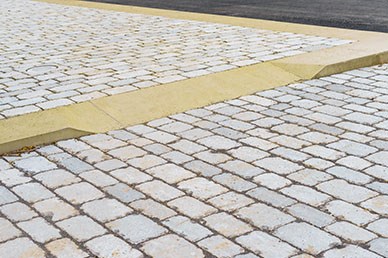
APPLY FOR GRANTS TO IMPROVE ACCESS TO SCHOOL FOR STUDENTS WITH DISABILITIES: EquallyAble
DOWNLOAD INFORMATION SHEETS, DRIVER TRAINING CURRICULA, AND OTHER RESOURCES FOR STUDENTS WITH DISABILITIES DURING THE PANDEMIC: Access Exchange International – including Let's Help Children with Disabilities Ride to School
PRIORITIZE TRANSPORTATION FOR VULNERABLE AND MARGINALISED POPULATIONS, INCLUDING STUDENTS WITH DISABILITIES: Getting Students with Disabilities Back to Class
PROVIDE ROAD SAFETY EDUCATION: EASST’s road safety education pack has been successfully used to educate students both with and without disabilities
ADAPT GLOBAL PRE-PANDEMIC EXAMPLES OF SAFE TRANSPORT FOR GIRLS: Women’s Safety and Security: A Public Transport Priority
ADAPT PRE-PANDEMIC TIPS FOR TRANSPORT STUDENTS EXPERIENCING HOMELESSNESS: Transportation for homeless children and youth: strategies for rural school districts
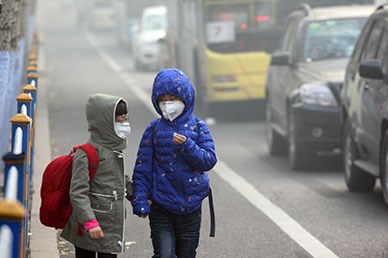
Fewer vehicles on the road, in part due to more walking and cycling, contributes to cleaner air. Clean air has never been so important, as air pollution has been linked to higher COVID-19 case and fatality rates. Air pollution causes a wide range of negative health outcomes, and disproportionately affects children and vulnerable groups. We must make sure that clean air is here to stay. Detailed guidance.
KEEP VEHICLES AWAY FROM SCHOOLS: Expand school streets. London has done this and closed off the roads around schools at key times. While there are many potential benefits of this, one is improved air quality. London is planning to use monitors to measure these air quality impacts, with support from the FIA Foundation.
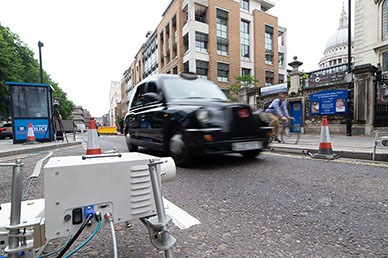
EMPOWER CHILDREN TO MEASURE AIR QUALITY AROUND SCHOOLS: Use an air quality toolkit as part of school activities with children to measure air pollution around their schools, raise awareness, and take action. This can even be done as part of an international collaboration and exchange. Experiences of working with students in London, Nairobi, and Delhi were used to inform a new British Council ‘Connecting Classrooms resource, which helps children learn about the impacts of air pollution.
COLLECT DATA TO CATALYZE CHANGE: The Mayor of London, UK committed to reducing taxi emissions by 65% by 2025 to improve the health of Londoners thanks to real-world emissions data from TRUE based on roadside testing.
ENCOURAGE WALKING AND CYCLING: Host an International Walk to School event to empower students to walk to school, encourage healthier practices, reduce traffic congestion, and limit carbon emissions and other harmful pollution. AIP Foundation’s Walk This Way program, for example, reached more than 200,000 students in Vietnam.
PUBLICLY DISPLAY AIR QUALITY: Use flags or digital alerts which match an air quality index to alert the public about daily air pollution levels so they can take actions to protect health, for example adjusting physical activities to help reduce exposure to air pollution while still keeping people active.
IMPROVE NATIONAL AND REGIONAL STANDARDS: Reduce emissions through Partnership for Clean Fuels and Vehicles (PCFV) and the Global Fuel Economy Initiative (GFEI), which has now updated its goal to be zero carbon vehicles.
FOCUS ON THE EXISTING STOCK OF USED VEHICLES, AND ENSURE COMPREHENSIVE POLICIES ARE IN PLACE.
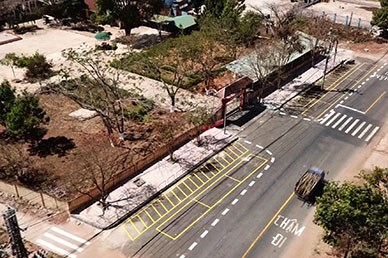
Ensure the school area is conducive to physical distancing during drop-off and pick-up. COVID-19 is less likely to spread outdoors than in an enclosed space, making school outdoor drop-off and pick-up ideal. There is also the opportunity to make the arrival area as welcoming as possible.
Measures to create additional space can be combined with those to increase road safety and reduce emissions. This includes prohibiting engine idling, and closing streets around schools to improve air quality and encourage walking and cycling. Additional crossing patrols (such as adapted scholar patrols) or staff to enforce no vehicle areas could also be considered as necessary to ensure that routes are safe.
Detailed guidance.
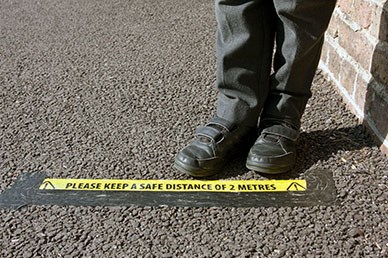
USE PHYSICAL DISTANCING MARKERS: Show students where to line up next to the school building, to avoid busy roads, using bollards to mark proper physical distancing or spray paint like in Denmark. Use bricks or rocks like schools in Botswana or circles on the ground like in Geneva.
DROP-OFF AT A DISTANCE: Establish a remote but walkable location like an empty parking lot to drop students off, like in Geneva or like New Zealand’s ‘kiss and go’ zones.
PAINT PARKING LINES FOR MOTORCYCLES TO SUPPORT DISTANCING: AIP Foundation did this in Vietnam, where large numbers of pupils arrive to school by motorbike.
RESTRICT TRAFFIC AROUND SCHOOLS: UK School Streets Initiative; NACTO Streets for Pandemic Response and Recovery School Streets designs